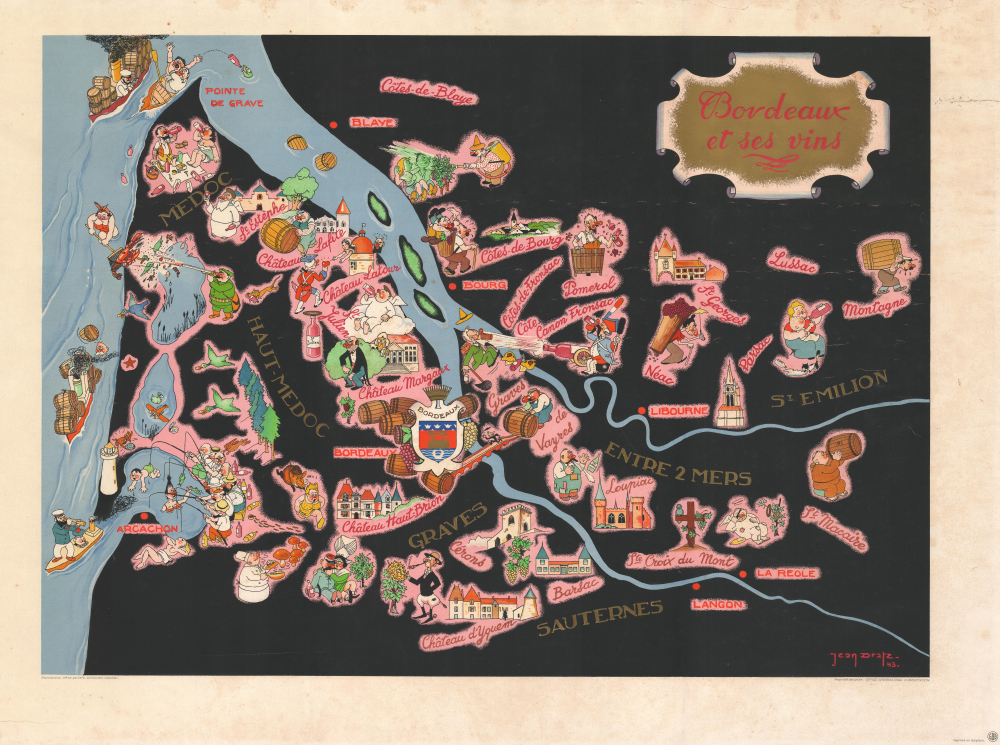This item has been sold, but you can get on the Waitlist to be notified if another example becomes available, or purchase a digital scan.
1943 Dratz Pictorial Cartoon Map Celebrating the Wines of Bordeaux, France
Bordeaux-dratz-1943
Title
1943 (dated) 32 x 23.5 in (81.28 x 59.69 cm)
Description
A Closer Look
Coverage focuses on the Bordeaux wine-producing region of the Gironde, particularly Médoc and St. Emilion. Against a black background, jolly images present a scene of bounty in sharp contrast to the wartime reality. Images entice with bountiful hunting and fishing, the rich regional gastronomy, sunbathing, picnicking, and, of course, wine production and consumption. Most of the cartoonish characters are overweight, with large red noses indicative of excessive wine consumption. At sea, several small boats shuttle barrels of wine, although it is unclear whether these are smugglers or legitimate shipments, perhaps intentionally so. The only indications of war and occupation are subtle and few, such as a German Heinkel He 111 bomber, recognizable for its distinctive shape and glass front, flying just north of Arcachon Bay.Chromolithography
Chromolithography, sometimes called oleography, is a color lithographic technique developed in the mid-19th century. The process uses multiple lithographic stones, one for each color, to yield a rich composite effect. Generally, a chromolithograph begins with a black base coat upon which subsequent colors are layered. Some chromolithographs used 30 or more separate lithographic stones to achieve the desired effect. Chromolithograph color can be blended for even more dramatic results. The process became extremely popular in the late 19th and early 20th centuries when it emerged as the dominant method of color printing. The vivid color chromolithography made it exceptionally effective for advertising and propaganda.Publication History and Census
This map was drawn in 1943 by the Belgian cartoonist Jean Dratz and printed in Belgium for the Office International d'Importation. The printer's logo 'GBB' appears in the lower right, and although we have been able to identify other wartime printings with this logo, we have been unable to unearth further information on the elusive company. We see no record of this map in any institutional collection or on the market. Exceedingly rare.Cartographer
Jean Pierre Gustave Dratz (Jean Dratz, Belgian Dubout; March 16, 1903 - October 12-13, 1967) was a Belgian painter, illustrator, cartoonist, and caricaturist. He was born in Mont-Saint-Guibert, Belgium. He received degrees in Law and Economics from the Université libre de Bruxelles but maintained a lifelong passion for art. This passion he inherited from his father, Constant Dratz (1875 - 1946), an artist best known for illustrations for the Belgian worker's movement and sober landscapes. Jean Dratz worked as an illustrator and co-founded the Belgian satirical artist association 'Mine Souriante.' He later worked on the design for the Brazil and Chile Pavilion at the 1935 Brussels Exposition Universelle and the Congo Pavilion at the 1958 Exposition Universelle et Internationale de Bruxelles. During the Nazi occupation of Belgium during World War II (1939 - 1945), he kept under the radar by avoiding politically volatile subject matters. Nonetheless, during this time, he was the artist director of the Flemish edition of Bravo! Due to Nazi censorship, he was forced to replace the newspaper's popular American comic strips, such as Flash Gordon with local strips, leading to the rise of the post-war comic industry in Belgium. More by this mapmaker...

